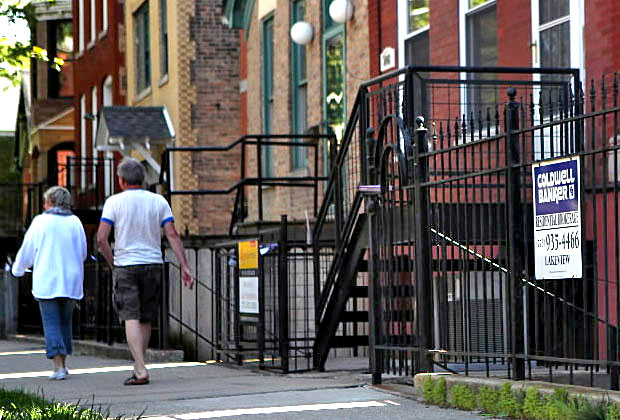In Chicago and around the country, the private individual home flipper is poised to make a comeback, suggests a report by national real estate brokerage Redfin using MLS data. For the first time since 2007, a majority of flips were performed by people rather than banks looking to clear foreclosures from their books—74.8%, in fact.
And, while the total number of flips—defined as purchases made with an eye for improvement and resold in less than a year—hasn’t quite returned to boom year levels (a reckless stretch), gross dollar gains from flips in 2013 were also the highest since 2007. In Chicago, that number was $86,700 per flip, with the national metro average at $90,200.
It should be stressed that Redfin’s data set isn’t perfect. It’s very hard to isolate intentional flips from circumstantial ones, where a resale comes unexpectedly. But the set captures a good percentage of the flipper market.
Thinking of breaking into the game? Be warned: flipping is inherently risky and far messier than it looks from afar. Many “independent” non-bank flippers are actually well capitalized, experienced investment firms or developers capable of securing loans with greater ease and expeditiousness than the amateur investor or first-time homebuyer. “They're being outbid by developers [on fixer-upper flips in transitioning neighborhoods],” says Redfin Chief Economist Nela Richardson. "There’s little room in many up-and-coming urban submarkets, including in Chicago, for the sweat equity that private buyers have traditionally poured into houses over longer periods of homeownership." Also, the percentage of buyers purchasing for the first time is alarmingly low—27% nationally, where it’s typically around 40%. This all has serious consequences for affordable housing.
“One observable trend in core neighborhoods of Chicago,” according to Redfin agent Al Medina, “is the de-conversion of two- and three-unit rental buildings in favor of single-family homes.”
That’s not where regular folks are investing, in flips or in basic home purchases. According to Medina, who’s flipped five homes in Chicago, you have to look to secondary submarkets where good homes still come relatively cheap but there are decent schools, transportation options, and mainstream amenities like supermarkets and big box stores. The Northwest section of bungalow belt does well in this regard—neighborhoods like Portage Park, Norwood Park, Albany Park, and Irving Park—along with spots like McKinley Park and Beverly on the South Side. The telltale signs of a ripe flipping submarket are rapidly appreciating but still low sales prices, short listing spans, and plentiful inventory.
All of the named neighborhoods above have the first two criteria in spades. For example, Redfin’s 48 recorded Irving Park sales in May 2013 had median prices and time on the market of $247,295 and 16 days. In May 2014, using 31 sales, those figures were $365,000 and five days. The other neighborhoods shared in this trajectory. Across the region, sales prices climbed 13.7% year-over-year, and time on the market fell from 27 to 23 days. In this respect, Chicago numbers mirror the national trend. Available inventory is where things deviate.
The Chicago area had literally zero change in inventory between May 2013 and May 2014, compared with a 9.1% average increase across metro areas. Some of the neighborhoods otherwise primed for flips and traditional purchases have actually had declining inventory, like Beverly (-14.8%), Irving Park (-7%), and Albany Park (-3.4%). Even though prices are rising, there are external factors keeping homeowners from selling. “An unstable, volatile job market affects sellers as much as buyers,” says Richardson. “They are less likely to invite change and uncertainty into their life by putting their home on the market.”
Richardson also ventures that we’ve arrived at a slowdown in local housing price appreciation and number of sales, which may be a market response to a shortage of first-time homebuyers and the fact that prices are outstripping personal income growth.
Economists want to see robust sales, because, according to Richardson, “real estate is a volume business.” It’s not enough to be setting records in high-end sales, making money for a few rich people. “We’re not yet seeing the sales numbers [locally and nationally] that point to a healthy market,” adds Richardson. Even though housing has been a historically safe place to put your money, in 2008 and 2009, more people lost money on flips across the country than made a profit. It was a 50/50 proposition in 2010-2011, and 2013 saw 77% of flipped homes clearing a profit.
Now back to the risks of flipping. “With the end of the 0% down financing days, risks [to and from flippers] are somewhat mitigated,” says Richardson. “Qualifications are a lot stricter when applying for loans for multiple investments.” And so, if you expect to compete with developers for the best buys you’d better arm yourself with on-the-ground information: comps, dynamics on the block, an understanding of improvement costs to a property, and an accurate sense of back-end profit potential. “You have to do your homework when borrowing other people’s money," says Medina. “It’s about being prepared.”



